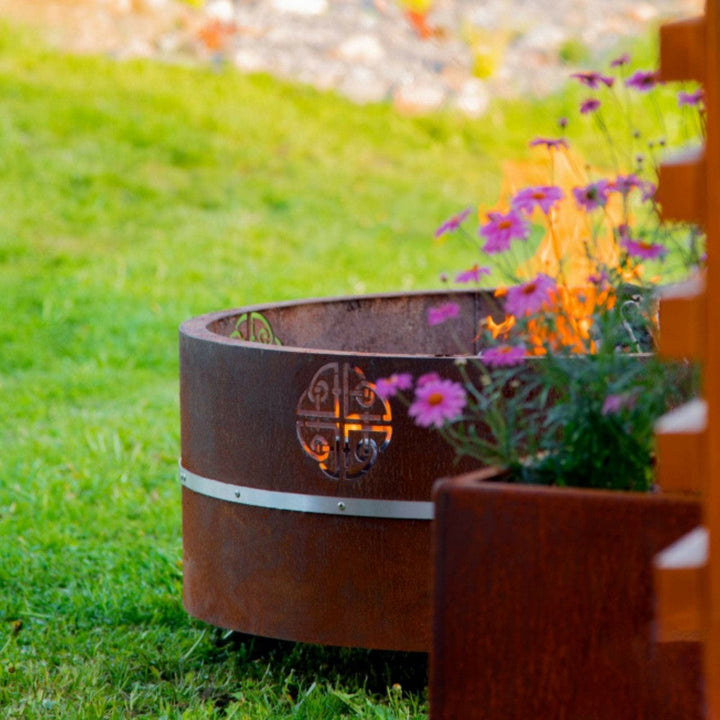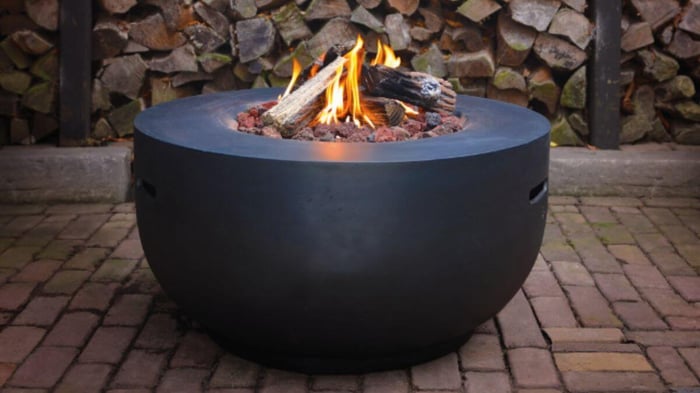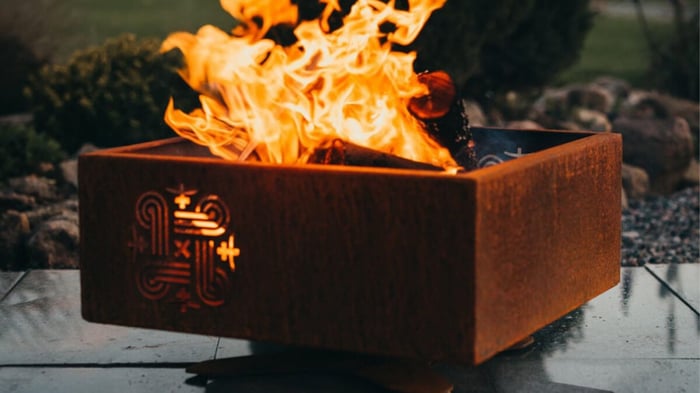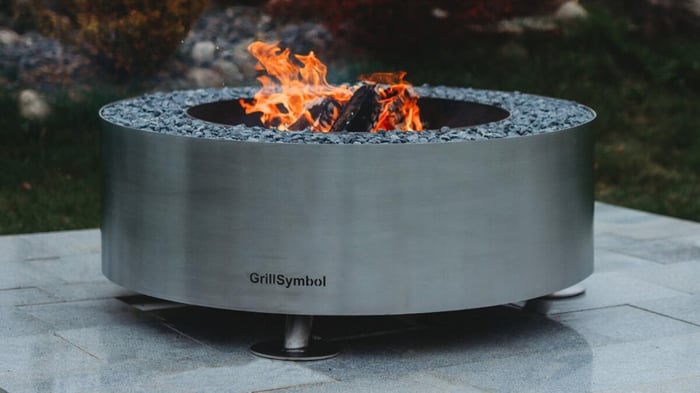Gas Fire Pit vs Wood Burning Fire Pit: Which Should I Buy and Why?
We know we are biased, but we love a good fire pit. They are a wonderful, beautiful, warming addition to any garden or outdoor space. They are the perfect spot to gather friends and family to enjoy the long summer evenings.
Choosing the right fire pit, however, can be a bit tricky. There are many options, but maybe you are undecided about whether you should go for a gas or wood-burning fire pit?
To help you make that decision, we have compiled our definitive guide to choosing the right fire pit.
So, which should you buy – a gas fire pit vs a wood-burning fire pit? Let’s look at the considerations you should have when making your decision…
Our Summary Wood Burning Fire Pit
-
Provides a more traditional and natural outdoor fire experience
-
Offers a unique and captivating flame pattern and crackling sound
-
Requires more maintenance, such as regular cleaning and refilling of firewood
-
Creates smoke and ash, which can be a problem for some people with allergies or respiratory issues
Our Summary For Gas Fire Pits
-
Offers convenience and ease of use, with simple push-button ignition and adjustable flame height
-
Generally produces less smoke and ash compared to wood-burning fire pits.
-
It may not provide the same sensory experience as a wood-burning fire pit, such as the smell of burning wood or crackling sounds.
-
It can be more expensive to purchase.
- Better for decking or partially-enclosed spaces like a gazebo
Fuel Availability
It may seem obvious, but the first thing to consider is the fuel used and its availability in your area. There’s no use in getting a fire pit that you can’t source the fuel for.
Gas fire pits use liquid propane or natural gas, and wood-burning fire pits need dry seasoned wood for fuel.
The simple answer is that both are readily available all over the country, though sourcing a good amount of top-quality wood in more urban areas will be a little harder and will likely be more expensive. Most order online and have the convenience of delivery to the door.
If using natural gas, then this isn't a consideration; you'll have fuel on tap.
Propane gas is always trickier as you usually need to exchange the propane bottle. Hardware stores and specialist gas suppliers.
How Much Storage?
We are specifically thinking about fuel storage here.
Storing wood can take up a lot of space, depending on how much you buy at once. On top of that, you must keep it dry, not only in your log store but also when near your fire pit for use.
Building a dry log store isn’t difficult; it also adds a lovely aesthetic to your garden.
Your gas fire pit also needs a sizeable storage tank for the propane, though not usually as much space as your log store. You can usually get gas containers with anything from 15 to 100 gallons.
However, gas tanks are less appealing to the eyes, so you may want to consider this and maybe work out a way to hide it in your landscape plan.
How Long Do They Take To Light?
As you can imagine, your gas fire pit will be far more efficient (and quicker) at lighting and at full combustion in no time pumping out that lovely heat for you. If you like a more impromptu use of your fire pit, gas may be the best choice.
Wood takes time and effort to get going, so a little more preparation is needed. Once it is blazing, however, it will generate a great amount of heat, and keeping it going is no effort.
What’s The Energy Efficiency?
For efficiency, your gas fire pit also takes the upper hand.
Gas burns far more cleanly and produces fewer emissions. Possibly as much as 99% fewer emissions than wood-burning fire pits.
The energy efficiency of a gas fire pit can be affected by factors such as the quality of the burners, the design of the fire pit, and the type of fuel used (natural gas or propane).
Gas fire pits that use natural gas as a fuel source tend to be more energy efficient than propane ones.
Wood fire pits emit approximately 28 pounds of particulate emissions into the atmosphere.
The energy efficiency of a wood-burning fire pit can be affected by factors such as the type of wood used, wood moisture level, the size of the fire pit, and the airflow.
Wood-burning fire pits that use well-seasoned hardwoods as fuel are more energy efficient than those that use softwoods or green wood. They also produce much less smoke.
How Much Will It Cost?
Depending on size, material, etc., costs can vary dramatically for wood-burning and gas fire pits.
To give you a rough idea, gas fire pits tend to range from around £800 all the way up to £2500. Do bear in mind that this doesn’t include the installation of a natural gas fire pit.
Wood-burning fire pits are much cheaper and can cost as little as £150 or up to nearly £2000.
How Much Maintenance Will My Fire Pit Need?
Wood-burning fire pits require far more maintenance than gas fire pits. Once used, they have the soot, ash, and half-burnt logs that need cleaning.
You also want to be careful when cleaning your wood fire pit as you may have an issue with creosote, which is a tar substance that comes from wood when burned. This is toxic when breathed in, so cleaning should be done with a mask and goggles.
On the other hand, gas fire pits need very little maintenance. There is nothing to clean out as the gas burns clean without soot or ash. It’s as simple as quickly wiping down and placing the cover to protect it from the elements.
What Is The Experience Like?
Let's face it, this test is subjective. We are all different and enjoy different things.
Gas is clean and simple. It doesn’t leave any odours on clothes, burns nicely, and maintains constant heat production.
On the other hand, wood-burning fire pits are primal. Just watching the flames can be mesmerising and wonderful for socialising. They are also great for marshmallows and cooking smoky BBQs.
You can use different woods to generate different smells, which can be a lovely experience. You also get the classic crackling sound from a good old-fashioned wood fire.
How Safe Are They To Use?
Safety is always a key concern when doing anything with fire or combustible. Both are safe, but an abundance of caution should always be exercised with fire.
With gas fire pits, it is important to check your gas system thoroughly to ensure no leaks and everything is running smoothly. Leaks can get out of hand quickly if they do happen, so being vigilant with safety is key.
In general, however, they are very safe if you keep your fire pit in good shape and check it regularly.
Wood-burning fire pits have their own safety considerations, the main one being to ensure that the fire and embers are completely out each time you finish using them.
Keeping your fire pits away from structures that can catch fire.
Here are some additional safety tips to keep in mind when using a wood-burning or gas fire pit:
-
Always supervise the fire pit when it is in use, and never leave it unattended.
-
Keep a fire extinguisher or bucket of sand nearby.
-
Do not allow children or pets to play near the fire pit.
-
Do not burn any flammable liquids in the fire pit, such as gasoline or lighter fluid.
-
Do not burn treated or painted wood; the chemicals can release toxic fumes.
- Keep the fire pit at least 10 feet away from flammable structures or materials, such as buildings, trees, bushes, and decks.
-
Ensure the fire is completely extinguished before leaving the area or going to bed.
Environmental Concerns?
Our environmental impact is important, and making the right choice can be difficult.
Wood is a renewable resource and so far more sustainable. On the other hand, gas is cleaner and emits far fewer toxins and CO2 into the atmosphere.
Again, the question may be how much you will use it. Consider the eco-friendly bio-ethanol fire pit if the environment is your primary concern.
Conclusion
There is no clear-cut answer as to which is better, a wood-burning fire pit or a gas fire pit. Both have their own pros and cons. Ultimately the decision will come down to what you are looking for and what kind of use you want to get out of your fire pit.
Hopefully, this article has given you the guidance you need to make the right choice.
Whatever you choose, we know you are going to love it! Unless you prefer Bioethanol... but that's another story!
Post Code Checker
Using a wood burner outside is legal; being a nuisance with an outdoor fire can cause problems with the neighbours and the local council. Here is our local council checker for their guidelines.
This is currently for postcodes in England and Wales. It will soon expand to Scotland and Northern Ireland.
Subscribe to our email
Enter your email address below for a monthly email with links to all the latest blog posts. Simple unsubscribe at any time.
GrillSymbol Lucas Fire Bowl Corten Steel 95cm

£990.00
GrillSymbol Lucas Fire Pit Corten Steel 95cm Diameter The Lucas is a large fire pit measuring 95cm in diameter. It has a Celtic design motif allows the light from the flames to shine through at night. The Lucas comes with an… Read More









